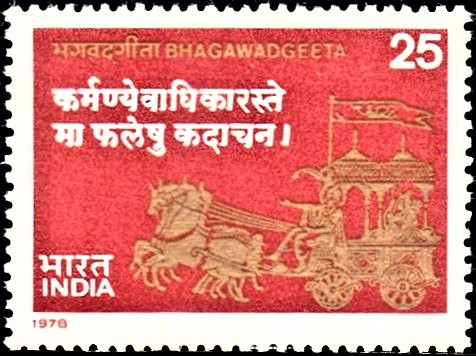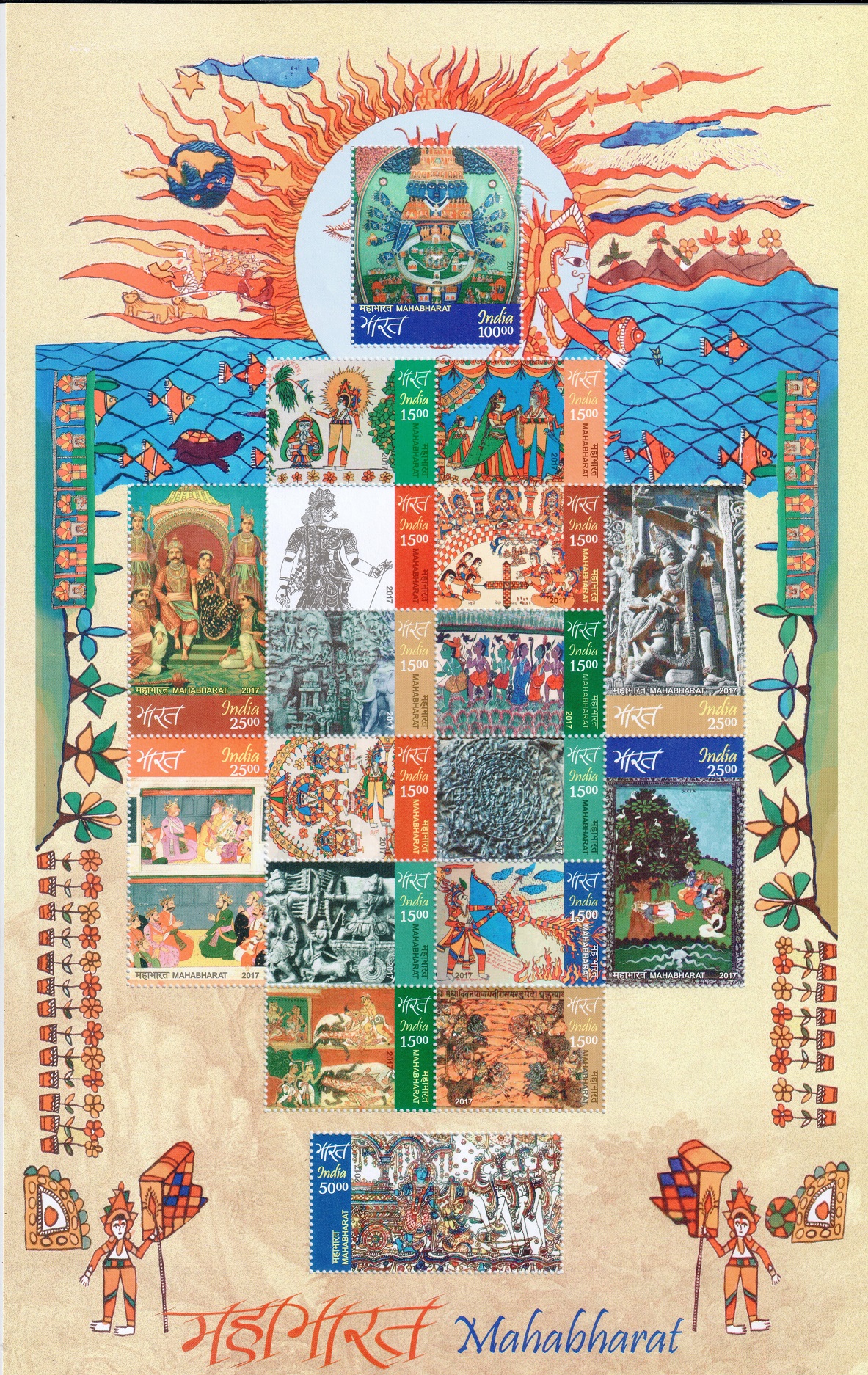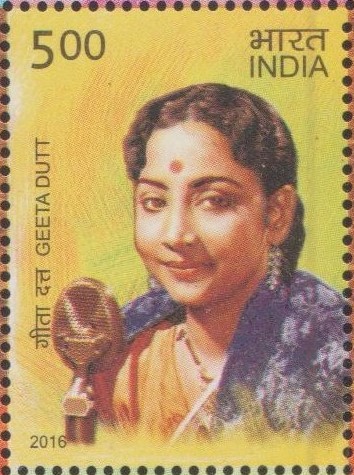
Bhagavad Gita
A commemorative postage stamp on Srimad Bhagawadgeeta (Bhagvadgita / Bhagawat Geeta), a 700-verse Sanskrit scripture, part of Hindu epic Mahabharata (Bhishma Parva) :
 Issued by India
Issued by India
Issued on Aug 25, 1978
Issued for : The P & T Department feels privileged to issue a special stamp in honour of Bhagawadgeeta.
Description of Design : The stamp shows the traditional picture of Krishna and Arjuna on the battle-field and a Stanza 47 of Chapter II of Bhagawadgeeta.
कर्मण्येवाधिकारस्ते
मा फलेषु कदाचन
(Thy right is to work only, but never to its fruits.)
The First Day Cover depicts a Kangra School painting or Geetopadesha reproduced by courtesy of National Museum, New Delhi. For the design of the background of the First Day Cover the Department is indebted to Sir J.J. Institute of Applied Art, Bombay.
Type : Stamp, Mint Condition
Colour : Light Bright Orange and Golden
Denomination : 25 Paise
Overall Size : 3.91 X 2.90 cms.
Printing Size : 3.55 X 2.54 cms.
Perforation : 13 X 13
Watermark : Unwatermarked paper
Number Printed : 50,00,000
Number per issue sheet : 35
Printing Process : Photogravure
Designed and Printed at : India Security Press
About :
- The Bhagavadgeeta, the Divine Song of the Lord, occurs in the Bhishma Parva of the great epic Mahabharata.
- It has been considered as a scripture of the highest authority by the great Acharyas like Sankara and Ramanuja and as a practical guide to living by generations in India and abroad.
- “The Geeta is the universal mother. She turns away nobody. Her door is wide open to anyone who knocks. A true votary of the Geeta does not know what disappointment is. He ever dwells in perennial joy and peace that passeth understanding. But that peace and joy come not to the sceptic or to him who is proud of his intellect or learning. It is reserved only for the humble in spirit who brings to her worship a fullness of faith and an undivided singleness of mind. There never was a man who worshipped her in that spirit and went back disappointed.“ — Mahatma Gandhi
- “The Geeta was not preached either as a pastime for persons tired out after living a worldly life in the pursuit of selfish motives, nor as preparatory lesson for living such worldly life, but in order to give philosophical advice as to how one should live one’s worldly life with an eye to Release, moksha, and as to the true duty of human beings in worldly life.“ — Lokmanya Tilak
- “The Geeta is one of the clearest and most comprehensive summaries of the perennial philosophy ever to have been done. Hence its enduring value, not only for Indians, but for all mankind.“ — Aldous Huxley
- “I believe in all the living languages of the world, there is no book so full of true knowledge, and yet so handy as the Bhagawadgeeta….It brings to men the highest knowledge, the purest love and the most luminous action. It teaches self–control, the three–fold austerity, non–violence, truth, compassion, obedience to the call of duty for the sake of duty, and putting up a fight against unrighteousness (Adharma)….“ – Madan Mohan Malaviya








Plz keep sending updates in email….very intersting information…thanks
[…] Bapat was also an erudite scholar. His published works include commentaries on Bhagwat Gita and the Upanishads and translations from Sri […]
[…] scripted on the banks of Saraswati river and Lord Krishna delivered the celestial message of the Shreemad Bhagavad Gita. Haryana was also a part of the Indus Valley Civilisation, with centres such as Banawali and […]
[…] Bengal Renaissance. Young Keshub made a deep study of Philosophy, History, Sanskrit literature, Gita and the Vedas. Rajnarayan Bose‘s tract on ‘Brahmoism‘ deeply influenced him and […]
[…] literary talents to write beautifully in Telugu to lead people to rational thought. His works on Bhagwad Gita, Soota Purana, Sambukavadha Khooni, Rana Pratap and Kurukshetra Sangramam stirred the masses to […]
[…] ‘The Cup‘, essays on politics, culture and religion. His lecture on the ‘Bhagvadgita‘ compiled as ‘Gita Tatparya‘ or ‘Jivanadharma Yoga‘ received the […]
[…] offers a wide variety of courses on Indian subjects, such as the Vedas, the Upanishads, the Bhagavad-Gita, the Darshanas, Vedanta, Vaishnavism, Shaivism, Jainism, Buddhism, Islam, Modern Hinduism and […]
[…] marching to gallows, he consoled his distressed mother by reminding her of her earlier teachings of Gita regarding the indestructibility of soul. So strong was his patriotic zeal that he pledged his next […]
[…] was profoundly influenced by the Bhagvad Gita and by the lives and teachings of Ramakrishna Parmahansa and Swami Vivekananda. She was also drawn […]
[…] Rajaji‘s books Marcus Aurelius and Socrates, the Vedanta, the Bhagvad Gita and the Upanishads, Voice of the Uninvolved, Kambaramayanam – Ayodhya Kandam are profound, […]
[…] ‘Sarv Bhoot hite Ratah’ based on Daivi Sampatti described in the Sixteenth Chapter of Srimad Bhagwad Gita. This organisation has been involved in propagating the qualities of fearlessness, full cleanliness […]
[…] great believer in the philosophy of Karma Yoga as enunciated by Lord Krishna in Gita, work was a passion with GD. He remained active till the end; death came to him in London on June […]
[…] believed in the Bhagavad Gita as a great source of inspiration for the struggle against the British. Swami Vivekananda’s […]
[…] compiled by Vyasa between 300 BCE and 300 CE, is considered to be of the Puranic Period. The Bhagvad Gita is narrated during the Bhisma Parva, just before the epiphanic moment of beginning of the great […]
[…] by his being rooted to the cultural-religious aspects of India. He had a deep understanding of the Bhagawat Gita, was in full adherence to Hindu traditions and culture and kept a disciplined life that had helped […]
[…] of Lord Krishna’s mythology comes from the Mahabharata and the very essence of the birth of the Bhagvad Gita. Lord Krishna’s personality is meant to be composite, wise yet youthful, strong yet tender, with […]
[…] might beg her forgiveness. Durga Mall was sitting on the throne of his room, where he was reciting Gita, and Mrs. Sharda Mall fainted after seeing her husband. He brought his wife back to her senses and […]
[…] a believer in social and religious reforms and a staunch follower of the tenets enshrined in the Gita. He built many educational, medical and religious institutions for the good of the people, but he […]
[…] humanitarian spirit transcended caste, color and religion. His life reflected the essence of Gita as well as the Sermon on the Mount. He taught to millions how to confront problems & challenges […]
[…] spiritual inclination was remarkable. At the age of nine he memorized seven hundred verses of the Bhagavad Gita in Sanskrit. From his early childhood, Bimala Prasad demonstrated a sense of strict moral […]
[…] lived at the Dumageri stone platform in Hubballi, he preached Sri Nijaguna’s Shastra, the Bhagavad-Gita, the Upanishads, the Panchadashi and secret of the Brahma–Sootras. His teachings, rooted in […]